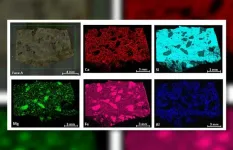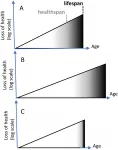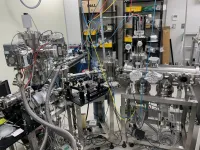Intensity not paramount for physical training during cancer therapy
2021-02-03
(Press-News.org) People receiving treatment for cancer are known to feel better with physical training. But does it make any difference how vigorously they exercise? A new study by researchers at Uppsala University shows that whether the training is intensive or rather less strenuous, its effect is roughly the same. The results are published in the journal Scandinavian Journal of Medicine and Science in Sports.
Physical activity and training during cancer therapy improve physical and mental health, and may also reduce the most common side effects of the treatment. This has been confirmed in several international studies. Many patients suffer from cancer-related fatigue, and both resistance and endurance training are known to lessen fatigue.
On the other hand, whether the intensity of the training is of any significance has yet to be clarified. Nor has it been ascertained whether extra support in the form of goal-setting, planning and self-monitoring of exercise brings improved results. To answer these questions, a randomised, controlled study known as Phys-Can (Physical training and Cancer) was implemented at the Universities of Uppsala, Linköping and Lund.
A total of 577 participants aged 30-84, recently diagnosed with breast, prostate or colorectal cancer, were randomised to undergo resistance and endurance training at either high or low-to-moderate intensity. In addition, half were randomly assigned to receive extra support in their training.
The resistance training was provided in instructor-led groups at Sweden's largest keep-fit club while the endurance training was home-based. The extra support given to half the participants was primarily a matter of assistance in planning their home-based endurance training and recording it in their diaries. The training period lasted six months.
After completion of the training, the two groups displayed differences. The group that had undergone high-intensity training suffered from somewhat less physical fatigue. They also had superior leg-muscle strength and slightly better fitness than the low-to-moderate intensity group. Regarding the extra support provided in the course of the training, no difference was found between the groups at follow-up. Accordingly, the additional support seems to have had no effect, given that the arrangements already entailed a great deal of support: thorough training instructions, a heart-rate monitor and instructor-led group training with other participants in a similar situation, for example.
"The conclusions we draw from the study are, first, that whether the training is of high or low-to-medium intensity doesn't seem to matter much. The groups' results didn't differ in a clinically relevant way - that is, there was no difference likely to make a difference in the patients' everyday life," says Ingrid Demmelmaier, Associate Professor of Physiotherapy at Uppsala University.
The researchers will return later with more results from the study concerning such aspects as the effects of the training on the participants' health in the longer term.
INFORMATION:
The Phys-Can project is led by Professor Karin Nordin of the Department of Public Health and Caring Sciences at Uppsala University.
[Attachments] See images for this press release:

ELSE PRESS RELEASES FROM THIS DATE:
2021-02-03
The IBeA research group from the University of the Basque Country's Department of Analytical Chemistry, Faculty of Science and Technology, is participating in NASA's Mars2020 space mission, which is scheduled to touch down on Mars in February this year. Specifically, the group has participated in constructing and verifying the chemical homogeneity of the templates included on the calibration card of the SuperCam instrument mounted on the Perseverance. 'We made a set of pads perfectly characterised in accordance the instruments we have here, in order to enable us to verify that the LIBS and Raman spectroscopy measurements taken by the SuperCam are correct,' explains Doctor Cristina García-Florentino. 'Raman spectroscopy is a technique ...
2021-02-03
The COVID-19 pandemic has had a profound effect on higher education -- shifting classes online, canceling events, and putting financial strain on institutions.
One area of academia that has actually shown positive increases, however, is the submission of research papers. A study conducted by Michelle Bell, Mary E. Pinchot Professor of Environmental Health at the Yale School of the Environment (YSE), and postdoctoral associate Kelvin C. Fong found the rate of manuscript submission to a major peer-reviewed journal (American Journal of Public Health) were higher during the pandemic -- but also revealed ...
2021-02-03
In the wake of repeated school shootings across the United States, today's youth have been called the mass shooting generation. A new study examined public support for arming school employees. The study found consensus for arming school resource officers, but division over whether to arm teachers and nonteaching staff. The research has clear implications for policy, including the possibility that support for arming school staff may diminish over time as young people (who are less supportive) make up a larger share of voters.
The study was conducted ...
2021-02-03
The properties of human mind affect the quality of scientific knowledge through the insertion of unconscious cognitive biases. Scientists from the University of Turku, Finland, have found that the current level of awareness about research biases is generally low among ecology scientists. Underestimation of the risks associated with unconscious cognitive biases prevents avoiding these risks in a scientist's own research. Due to unconscious origin of biases, it is impossible to combat them without external intervention.
When scientists use some device in their research, they always account for characteristics of this device, such as accuracy and precision. The human mind is the ...
2021-02-03
The findings of a new study examining the behaviours of alligator and caiman hatchlings have enhanced our understanding of how we can conserve, and increase, the population of endangered crocodilian species.
At adult size, there are key differences between the American alligator and the closely related spectacled caiman. However, at the time of hatching both species are tiny and might be expected to show similar behaviours in order to avoid being eaten by almost any carnivore around.
Now, researchers at the Universities of Lincoln and Vienna have conducted comparative studies between the hatchlings of these crocodilian creatures and found that the alligators are more active and likely to explore their surroundings.
The research, conducted at 'Crocodiles of the World', the only zoo ...
2021-02-03
Dr. Mikhail V. Blagosklonny, M.D., Ph.D., Editor-in-Chief of Oncotarget, and Professor, at Roswell Park Cancer Institute, published "The goal of geroscience is life extension" which was selected as the Featured Cover Paper for Volume 12 Issue 3 and reported that although numerous drugs seemingly extend healthspan in mice, only a few extend lifespan in mice and only one does it consistently. Some of them, alone or in combination, can be used in humans, without further clinical trials.
Dr. Mikhail V. Blagosklonny from The Roswell Park Cancer Institute said, "Although we do not know everything about aging, we now know enough to start its pharmacologic suppression using ...
2021-02-03
Massive galaxies with extra-large extended "puffy" disks produced stars for longer than their more compact cousins, new modelling reveals.
In a paper published in the Astrophysical Journal, researchers led by Dr Anshu Gupta and Associate Professor Kim-Vy Tran from Australia's ARC Centre of Excellence in All Sky Astrophysics in 3 Dimensions (ASTRO 3D), show that the sheer size of a galaxy influences when it stops making new stars.
"There's a period in the life of the Universe known as the 'cosmic noon', which occurred about 10 billion years ago," said Dr Gupta.
"That was when star formation in massive galaxies was at ...
2021-02-03
New research suggests that the rate of rainfall within a storm system is linked to the structure and form of the precipitation area as seen on radar. This discovery relies heavily on the "morphology" of radar signatures, including shape (big, small), and size (high, short or plump, thin). Compared to buying diamonds, morphological characteristics are an important reference factor for pricing. Fascinated by "popcorn-shaped" clouds over the Tibetan Plateau, atmospheric scientists have been inspired to study the relationship between cloud shape, precipitation intensity, and the morphology ...
2021-02-03
Hokkaido University scientists show that under laboratory conditions, ultraviolet light reacts with nitrophenol to produce smog-generating nitrous acid.
An advanced laser technique has allowed researchers to observe, in real-time, the decomposition of a pollutant into atmospheric nitrous acid, which plays a key role in the formation of ozone and photochemical smog. The technique, described by Hokkaido University researchers in The Journal of Physical Chemistry Letters, could be used in a wide range of applications.
Nitrophenols are a type of fine particulate matter found in the atmosphere that form as a result of fossil fuel combustion and from forest fires. It is hypothesised that light interacts with nitrophenols and breaks them down into nitrous acid; atmospheric nitrous ...
2021-02-03
Social interaction may help reverse food and cigarette cravings triggered by being in social isolation, a UNSW study in rats has found.
The study, published in Scientific Reports, used an animal model of drug addiction to show that a return to social interaction gives the same result as living in a rich, stimulating environment in reducing cravings for both sugar and nicotine rewards.
"This was an animal study, but we can probably all relate to the mental health benefits of being able to go for a coffee with our friends and having a chat," lead author Dr Kelly Clemens from UNSW Sydney's School of Psychology ...
LAST 30 PRESS RELEASES:
[Press-News.org] Intensity not paramount for physical training during cancer therapy





